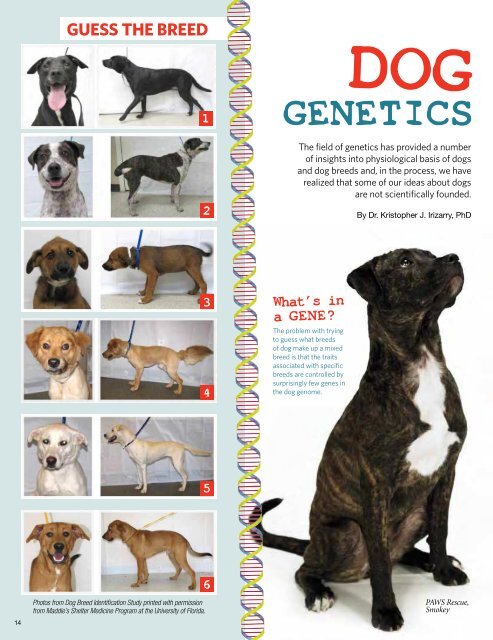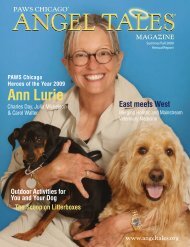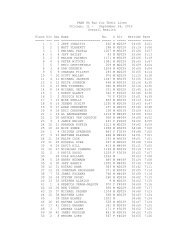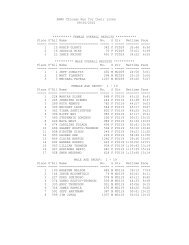Create successful ePaper yourself
Turn your PDF publications into a flip-book with our unique Google optimized e-Paper software.
GUESS THE BREED<br />
1<br />
2<br />
3<br />
4<br />
5<br />
6<br />
DOG<br />
GENETICS<br />
The field of genetics has provided a number<br />
of insights into physiological basis of dogs<br />
and dog breeds and, in the process, we have<br />
realized that some of our ideas about dogs<br />
are not scientifically founded.<br />
What’s in<br />
a GENE?<br />
The problem with trying<br />
to guess what breeds<br />
of dog make up a mixed<br />
breed is that the traits<br />
associated with specific<br />
breeds are controlled by<br />
surprisingly few genes in<br />
the dog genome.<br />
By Dr. Kristopher J. Irizarry, PhD<br />
The canine genome was<br />
sequenced in publicly released<br />
in December of 2005, since that<br />
time many genetic studies have<br />
been conducted whereby saliva<br />
or blood from members of specific<br />
breeds is used to look for<br />
shared genes among members<br />
of the same breed. Some of these<br />
findings have elucidated genes<br />
associated with health problems<br />
while other studies have<br />
identified specific genes that are<br />
associated with specific breed<br />
defining visual traits such as coat<br />
color, coat length, body size and<br />
head shape, to name a few.<br />
Interestingly, many people try<br />
to determine the breed composition<br />
of a mixed breed dog by<br />
looking at visual traits and<br />
mentally assigning those traits<br />
to different breeds. This practice<br />
has been accepted for quite some<br />
time, decades, maybe even hundreds<br />
of years. However, what<br />
genetics tells us is that visually<br />
assigning breed doesn’t work. The<br />
truth is people can’t do it. Some<br />
may think with training or practice<br />
one might be able to improve,<br />
but that’s not the case.<br />
The problem with trying to<br />
guess what breeds of dog make<br />
up a mixed breed is that the traits<br />
associated with specific breeds<br />
are controlled by surprisingly<br />
few genes in the dog genome. In<br />
humans, we know that identical<br />
twins look the same because they<br />
share the same DNA. It is natural<br />
to assume that dogs with a similar<br />
visual physical appearance probably<br />
share the same DNA, but<br />
genetic studies have shown us<br />
why that assumption is incorrect.<br />
In a 2010 paper entitled<br />
“a simple genetic architecture underlies<br />
morphological variation<br />
in dogs” by Boyko et al, geneticists<br />
analyzed more than 60,000<br />
regions of the dog genome that<br />
are known to be variable between<br />
dogs and breeds. They specifically<br />
looked at 915 dogs from 80<br />
dog breeds–corresponding to 55<br />
million data points (60,000 times<br />
915 = 54,900,000). Their findings<br />
are very surprising and show that<br />
the major breed defining traits<br />
in dogs, such as body size, ear<br />
shape, length of legs, coat color,<br />
length of fur, head shape and<br />
length of snout are controlled by<br />
very few regions of the genome.<br />
In fact, the authors of the study<br />
state that only roughly 50 regions<br />
control all of these traits. Some of<br />
the exact same versions of these<br />
genes are found in many different<br />
breeds which means that a mixed<br />
breed dog might have the size and<br />
shape of a certain breed without<br />
being even a little bit that breed!<br />
So unlike humans, in which<br />
identical twins share all of their<br />
DNA, in dog breeds, like German<br />
Shepherds, there are surprisingly<br />
few genes controlling the physical<br />
appearance of the members<br />
of the breed. This unexpected<br />
result means that when you see<br />
a mixed breed dog about the size<br />
of a German Shepherd, with a<br />
long snout, erect ears and long<br />
black hair – it isn’t necessarily a<br />
German Shepherd, in fact, it<br />
may not even have any German<br />
Shepherd ancestors because those<br />
visual traits may be the result<br />
of about 10 genes in the dog’s<br />
genome. Considering that there<br />
are more than 20,000 genes<br />
encoded in the canine genome,<br />
what you see isn’t necessarily what<br />
you get when trying to guess what<br />
breeds make up a mixed breed<br />
dog. The take home message<br />
from this study is: “Don’t judge a<br />
dog by its external appearance.”<br />
Dr. Kristopher Irizarry is an Associate<br />
Professor of Bioinformatics, Genetics<br />
and Genomics at the Western University<br />
College of Veterinary Medicine.<br />
University of Florida Dog Breed<br />
Identification Study<br />
Dr. Julie Levy, DVM, of the University of Florida<br />
Maddie’s Shelter Medicine Program recently<br />
conducted a study on Dog Breed Identification. This<br />
study consisted of a national survey of more than<br />
5,000 dog experts to compare their best guesses for<br />
the breeds of dogs in a series of photographs with<br />
the DNA breed profiles for the dogs.<br />
Six examples of dogs in the study are featured on<br />
page 14. Compare your best guess of their breeds<br />
with those of dog experts and actual DNA results.<br />
ANSWERS TO GUESS THE BREED<br />
ACTUAL<br />
BREEDS FROM<br />
DNA TEST<br />
EXPERTS’<br />
BEST GUESS<br />
Photos from Dog Breed Identification Study printed with permission<br />
PAWS Rescue,<br />
from Maddie’s Shelter Medicine Program at the University of Florida.<br />
Smokey<br />
Golden Retriever<br />
14 15<br />
Dog 1<br />
50% Catahoula Leopard Dog<br />
25% Siberian Husky<br />
9.94% Briard<br />
5.07 Airedale Terrier<br />
Dog 2<br />
25% Miniature Pinscher<br />
25% Great Pyrenees<br />
10.79% Afghan Hound<br />
10.09% Nova Scotia Duck<br />
Tolling Retriever<br />
Dog 3<br />
50% American Eskimo<br />
25% Cane Corso<br />
25% Chinese Sharpei<br />
Dog 4<br />
25% Siberian Husky<br />
25% American Bulldog<br />
11.89% German Spitz<br />
5.91% Standard Schnauzer<br />
Dog 5<br />
25% Beauceron<br />
25% Siberian Husky<br />
25% American Staffordshire Terrier<br />
12.73% Schipperke<br />
Dog 6<br />
25% Rottweiler<br />
25% American Eskimo<br />
25% Portuguese Water Dog<br />
15.23% Bulldog<br />
Labrador Retriever<br />
American Staffordshire Terrier<br />
No Predominant Breed<br />
Border Collie<br />
Pointer (includes English Pointer)<br />
Australian Cattle Dog<br />
German Shorthaired Pointer<br />
Pointer (includes English Pointer)<br />
Border Collie<br />
No Predominant Breed<br />
German Shepherd Dog<br />
No Predominant Breed<br />
Belgian Malinois<br />
Labrador Retriever<br />
Beagle<br />
Golden Retriever<br />
Chow Chow<br />
No Predominant Breed<br />
Pomeranian<br />
Nova Scotia Duck Tolling Retriever<br />
Labrador Retriever<br />
German Shepherd Dog<br />
No Predominant Breed<br />
Golden Retriever<br />
Anatolian Shepherd Dog<br />
Labrador Retriever<br />
No Predominant Breed<br />
German Shepherd Dog<br />
Rhodesian Ridgeback
















